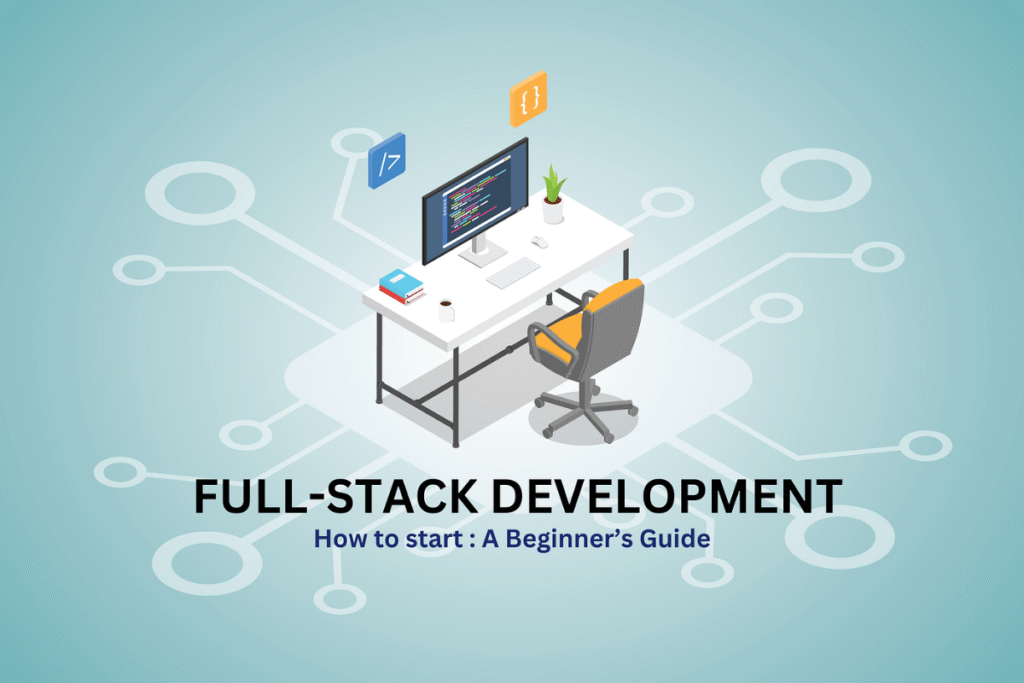Introduction
Web development is one of the most in-demand skills in the digital age. Whether you want to become a freelance developer, work with startups, or land a job at top tech companies, web development opens doors to countless opportunities.
This beginner’s guide will walk you through the entire journey of becoming a web developer — starting with HTML basics and moving towards full-stack mastery. You’ll learn what tools to use, which skills to prioritize, and how to build projects that showcase your abilities.
Step 1: Understanding the Basics of Web Development
Before diving into coding, it’s important to know the core areas of web development. Web development is broadly divided into two main parts:
- Frontend (Client-Side): Everything users see on a website — text, images, design, navigation, etc.
- Backend (Server-Side): The behind-the-scenes logic that powers websites — databases, APIs, user authentication, etc.
Here’s a basic information table that highlights the foundation of web development:
| Component | Description | Example Tools / Languages |
|---|---|---|
| HTML (Structure) | The backbone of web pages; defines content like text, images, links. | HTML5 |
| CSS (Styling) | Styles the web page — colors, fonts, layout, animations. | CSS3, Tailwind, Bootstrap |
| JavaScript | Adds interactivity — forms, buttons, dynamic content. | Vanilla JS, React, Vue, Angular |
| Backend (Logic) | Handles server requests, processes data, and connects to databases. | Node.js, Python (Django/Flask), PHP |
| Database | Stores and retrieves data like users, products, or blog posts. | MySQL, MongoDB, PostgreSQL |
| Full-Stack | Combination of frontend + backend + database management. | MERN, MEAN, LAMP, Django-React Stack |
Step 2: Learning HTML – The Structure of the Web
- HTML (HyperText Markup Language) is the skeleton of every website.
- Tags like
<h1>,<p>,<a>, and<img>help organize content. - Start by creating simple static pages like “About Me” or a “Portfolio Page.”
Tip: Use VS Code as your editor for writing HTML with live server preview.
Step 3: Mastering CSS – The Style Layer
- CSS (Cascading Style Sheets) makes your website look beautiful.
- Learn about selectors, classes, IDs, and box model.
- Responsive design (using media queries or frameworks like Bootstrap) ensures your site works on mobile and desktop.
Example project: Design a personal resume webpage with styled layouts.
Step 4: JavaScript – Adding Interactivity
- JavaScript makes websites dynamic.
- Learn DOM manipulation, event handling, and basic ES6 concepts.
- Explore frameworks like React for modern UI development.
Example project: Build a simple to-do list app where users can add and remove tasks.
Step 5: Backend Development – Powering the Logic
- Backend handles what happens behind the scenes.
- Learn a backend language such as:
- Node.js (JavaScript)
- Python (Django/Flask)
- PHP
- Understand APIs and how data flows between client and server.
Example project: Create a simple user login system with sessions.
Step 6: Databases – Storing Information
- Databases are the brain of web applications.
- Learn SQL-based (MySQL, PostgreSQL) and NoSQL-based (MongoDB) systems.
- Practice CRUD operations (Create, Read, Update, Delete).
Example project: Build a blog database to store posts and comments.
Step 7: Full-Stack Development – Bringing It All Together
- A full-stack developer knows both frontend and backend.
- Popular stacks include:
- MERN (MongoDB, Express, React, Node.js)
- LAMP (Linux, Apache, MySQL, PHP)
- Django + React/Vue
Example project: Build a complete e-commerce site with user accounts, product listings, and a shopping cart.
Step 8: Version Control with Git & GitHub
- Git helps track changes in your code.
- GitHub allows collaboration and showcasing your projects to employers.
- Learn commands like
git init,git commit,git push.
Step 9: Deployment – Making Your Website Live
- Use platforms like Netlify, Vercel, or GitHub Pages for frontend projects.
- For full-stack, try Heroku, AWS, or DigitalOcean.
Step 10: Building a Portfolio & Continuous Learning
- Create a portfolio website showcasing your projects.
- Contribute to open-source projects.
- Stay updated with trends like AI in web development, Jamstack, and Progressive Web Apps (PWAs).
Conclusion
Becoming a web developer is a journey, not a one-day process. Start small with HTML and CSS, gradually explore JavaScript, and then dive into backend and databases. Finally, combine everything to become a full-stack developer.
With consistent practice and real-world projects, you’ll be job-ready in months.

